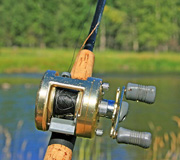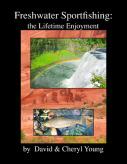Bait Casting
Bait casting tackle calls for more skill in line and spool control than spin casting. Backlashes have been a problem since the advent of bait casting reels. They arise when the spool revolves faster than the outgoing lure. What a mess it is to untangle. I seem to backlash right at the wrong time.
To prevent or minimize backlashes, fine tune the spool adjustment knob to the weight of the lure to be cast. Do this by raising the rod with the lure about six inches from the tip. Engage the free spool and gently remove your thumb from the spool. The lure should slowly and smoothly drop to the floor without over running the spool. Loosen or tighten this anti-backlash knob until it does so. Now you’re ready to cast.
The same casting stroke is used in bait casting as in spin casting. The only difference is that I like to use a longer arc that more smoothly accelerates the rod. Of course the free spool button is engaged and your educated thumb is pressed to the spool. Once the rod makes the sudden stop to cast the lure, this thumb gently releases the pressure off of the real spool. I don’t want it to jump the spool into high speed, so I gently release the thumb pressure. Once the lure is in flight, I watch the outgoing line and the cast lure. I want the line to go out at the same speed as the lure. Towards the end of the cast, the thumb gently and progressively slows down the revolving spool.
The proper spool anti-backlash adjustment and the smart thumb pressure eliminate the possibility of a backlash.
Again, with light lures and fragile baits, I eliminate the back cast motion of the rod. All wrist and elbow motions are progressive accelerations. That is they start out slowly and increase until the rod stop portion of the cast. The same variety of casts is possible in bait casting as in spin casting.

I like to overcast my target and use light thumb pressure to slow down my lure. That way I can pretty will eliminate the bird’s nest of line in a backlash.
I like to use casting tackle for heavier lures and baits. I also love to free spool the line out as my bait drifts down stream. I simply put it in free spool and

allow the line to flow from the light pressure of the thumb on the revolving spool.
Casting reels have very smooth star drags and all you have to do is to add a little thumb pressure to the spool when you want to increase the drag.
You can also crank in while the line is being pulled out by a fish without twisting the line. If you were to reel in while the fish was pulling line off a spinning reel, you would cause about four new line twists for every reel handle rotation.
Practice bait casting on your lawn or neighborhood park. Make yourself fish exclusively with a bait caster on a weekend trip. Take the time to master the bait caster. You’ll be glad that you did

© 2025 The Gale Group, Inc. All rights reserved.
© 2025 Perigee Learning LLC. All rights reserved.
LoveTheOutdoors.com is owned and operated by Advameg, Inc. © 2025 Advameg, Inc.
Camping Adventures • Dutch Oven Cooking • Sports Knots
Fly Tying • Freshwater Fishing • Fly Fishing

